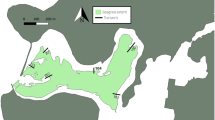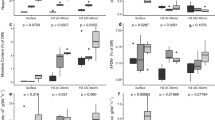Abstract
Net annual primary production of a sedge Carex lyngbyei dominated tidal marsh in the Fraser River estuary, British Columbia, Canada was 634 g ash-free dry weight (AFDW) per m2 per yr (687 g dry weight per m2 per yr). Mean maximum shoot elongation during the short (May to August) growing season was 1.88 cm per day from overwintering shoots. The maximum aboveground standing crop of 690 g AFDW per m2 represented only 25% of the total below-ground biomass, which appears to be controlling most of the critical life history processes of the sedge marsh. An estimate of 14 percent of the aboveground standing crop was lost through leaching of dissolved organic carbon from the growting plant. Aboveground tissue losses, which were negligible during the growing season, occurred primarily via translocation in autumn and tidal export during the winter. In situ measurements showed that of the original maximum standing crop, approximately 38%, 37%, and 25% were lost by downward translocation, tidal export, and sediment burial, respectively. Based on changes in above and belowground nutrient pools, rapid spring (May to late June) uptake rates of 109 mg N per m2 per day and 23.0 mg P per m2 per day by shoots were followed by downward translocation rates of 44.8 mg N per m2 per day and 12.2 mg P per m2 per day during late June to the end of August. Aboveground leaching rates were estimated as 23.9 mg N per m2 per day and 7.8 mg P m2 per day and belowground uptake rates as 100 mg N per m2 per day and 26 mg P per m2 per day; root uptake occurred primarily after late June. Nutrient levels in decomposing litter more than doubled over the winter period showing a pattern of nutrient enrichment characteristic of marsh ecosystems. *** DIRECT SUPPORT *** A01BY023 00004
Similar content being viewed by others
Literature Cited
American Public Health Association. 1971. Standard methods for the examination of water and wastewater. APHA, 13th edition.
Auclair, A. N. D., A. Bouchard, and J. Pajaczkowski. 1976. Productivity relations in a Carex dominated ecosystem. Oecologia 26:9–13.
Bernard, J. M. 1973. Production ecology of wetland sedges. The genus Carex. Pol. Arch. Hydrobiol. 20:207–214.
Bernard, J. M. 1974. Seasonal changes in standing crop and primary production in a sedge wetland and an adjacent dry old-field in central Minnesota. Ecology 55:350–359.
Bernard, J. M., and J. G. MacDonald. 1974. Primary production and life history of Carex lacustris. Can. J. Bot. 52:117–123.
Boyd, C. E. 1969. Production, mineral nutrient absorption, and biochemical assimilation by Justicia americana and Alternanthera philoxeroides. Arch. Hydrobiol. 66:139–160.
Burg, M. E., D. R. Tripp, and E. S. Rosenberg. 1980. Plant associations and primary productivity of the Nisqually salt marsh of Southern Puget Sound, Washington. Northwest Sci. 54:222–236.
Chapman, D. H., and P. F. Pratt. 1961. Methods of analysis for soils, plants and waters. Univ. Cal. Div. Agr. Sci.
Cruz, A. A. Dela, and B. C. Gabriel. 1974. Caloric, elemental and nutritive changes in decomposing Juncus roemerianus leaves. Ecology 55:882–886.
Eilers, H. 1975. Plants, plant communities, net production and tide levels: the ecological biogeography of the Nehalem salt marshes, Tillamook County, Oregon. Ph.D. Thesis, Oregon State University.
Fonda, R. W., and L. C. Bliss. 1966. Annual carbohydrate cycle of alpine plants on Mt. Washington, New Hampshire. Bull. Torr. Club 93:268–277.
Gallagher, J. L., W. F. Pfeiffer, and L. R. Pomeroy. 1976. Leaching and microbial utilization of dissolved organic carbon from leaves of Spartina alterniflora. Estuarine Coastal Mar. Sci. 4:467–471.
Gerloff, G. C., and P. H. Krombholz. 1966. Tissue analyses at a measure of nutrient availability for the growth of angiosperm aquatic plants. Limnol. Oceanogr. 11:529–539.
Good, R. E., D. F. Whigham, and R. L. Simpson. 1978. Freshwater Wetlands. Ecological Processes and Management Potential. Academic Press, Inc.
Hardisky, M. A., and R. J. Reimold. 1977. Saltmarsh geratology. Science 198:612–614.
Hatcher, B. G., and K. H. Mann. 1975. Aboveground production of marsh cordgrass (Spartina alterniflora) near the northern end of its range. J. Fish. Res. Board Can. 32:83–87.
Hitchcock, C. L., and A. Cronquist. 1973. Flora of the Pacific Northwest. University of Washington Press.
Hopkins, C. S., J. G. Gosselink, and R. T. Parrondo. 1978. Aboveground production of seven marsh plant species in coastal Louisiana. Ecology 59:760–769.
Jefferson, C. A. 1975. Plant communities and succession in Oregon coastal salt marshes. Ph.D. Thesis, Oregon State University.
Kirby, C. J., and J. G. Gosselink.1976. Primary production in a Louisiana Gulf coast Spartina alterniflora marsh. Ecology 57:1052–1059.
Levings, C. D., and A. E. Moody. 1976. Studies of intertidal vascular plants, especially sedge (Carex lyngbyei) on the disrupted Squamish River delta, B.C. Fish. Mar. Serv. Report No. 606.
Linthurst, R. A., and R. J. Reimold. 1978. An evaluation of methods for estimating the net aerial primary productivity of estuarine angiosperms. J. Appl. Ecol. 15:919–931.
McRoy, C. P., R. J. Barsdate, and M. Nebert. 1972. Phosphorus cycling in an eelgrass (Zostera marina L.) ecosystem. Limnol. Oceanogr. 17:58–67.
Mooney, H. A., and W. D. Billings. 1960. The annual carbohydrate cycle of alpine plants as related to growth. Am. J. Bot. 47:594–598.
Morrison, S. J., J. D. King, R. J. Bobbie, R. E. Bechthold, and D. C. White. 1977. Evidence for microfloral succession on allochthonous plant litter in Appalachicola Bay, Florida, U.S.A.. Mar. Biol. 41:299–240.
Nelson, D. W., and L. E. Sommers. 1973. Determination of total nitrogen in plant material. Agronomy J. 65:109–112.
Odum, W. D. 1978. The importance of tidal freshwater wetlands in coastal zone management. Coastal Zone'78 Symp., San Francisco, Cal.,Vol. II, p. 1196–1203.
Odum, E. P., and M. E. Fanning. 1973. Comparison of the productivity of Spartina alterniflora and Spartina cynosuroides in Georgia coastal marshes. Bull. Ga. Acad. Sci. 31:1–12.
Prentki, R. T., T. D. Gustafson, and M. S. Adams. 1978. Nutrient movements in lakeshore marshes, p. 169–194. In Good et al. (eds.), Freshwater Wetlands. Academic Press.
Smalley, A. E. 1959. The growth cycle of Spartina and its relation to the insect population on the marsh. Proc. Salt Marsh Conf., Sapelo Is. Georgia.
Turner, R. E. 1976. Geographic variations in salt marsh macrophyte production: A review. Contrib. Mar. Sci. 20:47–68.
Valiela, I., and J. M. Teal. 1977. Inputs, outputs and interconversions of nitrogen in a salt marsh ecosystem. Paper presented at the 1st European Ecol. Symp., Norwich, U.K.
Wetzel, R. G., and B. A. Manny. 1972. Secretion of dissolved organic carbon and nitrogen by aquatic macrophytes. Verh. Internat. Verein. Limnol. 18:229–240.
Woodwell, G. M., and D. E. Whitney. 1977. Flax pond ecosystem study: exchanges of phosphorus between a salt marsh and the coastal waters of Long Island Sound. Mar. Biol. 41:1–6.
Author information
Authors and Affiliations
Rights and permissions
About this article
Cite this article
Kistritz, R.U., Hall, K.J. & Yesaki, I. Productivity, detritus flux, and nutrient cycling in a Carex lyngbyei tidal marsh. Estuaries 6, 227–236 (1983). https://doi.org/10.2307/1351514
Received:
Accepted:
Issue Date:
DOI: https://doi.org/10.2307/1351514




